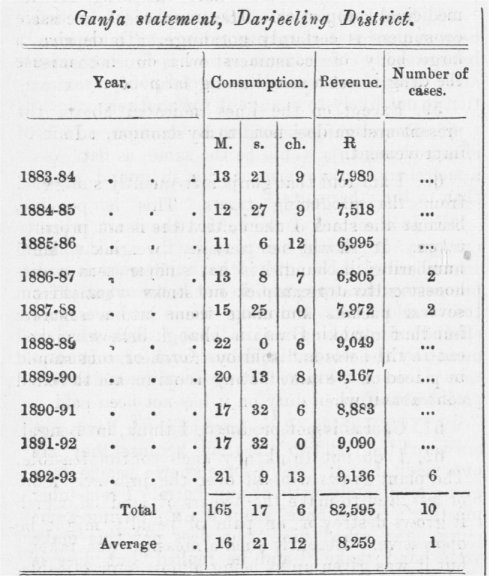22. .Evidence of MR. R. T. GREER, Deputy Commissioner of Darjeeling.
| Reports - Indian Hemp Commission Report |
Drug Abuse
22. .Evidence of MR. R. T. GREER, Deputy Commissioner of Darjeeling.

It will be seen from this statement that only to a nominal extent is Darjeeling a ganja-consuming district. The average quantity per year consumed during the last ten years has been 164 maunds, yielding an average yearly revenue of 1t8,259. The population of the district being 2,23,314, the incidence of the tax per head of population comes to (R0-0-7) seven pies and consumption to quarter of a tole, per annum.
The consumers are chiefly confined to the lower classes of up-country residents (dhobies, mochies, sweepers, sadhus, bhakats and fakirs), amongst plainsmen and Nepalese, Rajbansis and Muhammadans in the Terai, and a small fraction of the Btngali population.
The bulk of the hill population, Bhutias and Lepchas as a class, and Nepalese to a great extent, are non-consumers. One shop at Darjeeling (fee 1160 a month) and one at Kurseong (fee 1120 a month) are the only licensed places of sale in the hills.
The ganja plant grows wild abundantly in this district, mostly below the elevation of 4,000 feet above sea level. The Nepalese know the use of this plant, and the sadhus commonly prepare from it a crude sort of ganja for smoking which they call bbang. They never drink or eat the product as bhang, but always smoke it like ganja.
Ordinary consumers use two pies worth of ganja in two chilluras a day, and hard smokers more than two annas worth (or a half tola) per day. Bhang is imported from the plains by upcountry men for their own consumption.
The consumption of ganja is regarded with disfavor by the general population, certain classes of religious mendicants only being freely allowed the privilege' not for the purpose of intoxication, but as a help for the concentration of their thoughts in divine contemplation.
As regards this district the use of ganja is not abused to any serious extent. The stoppage of the sale of the drug would inevitably encourage illicit cultivation, and drive the present consumers to the use of other obnoxious intoxicants.
Ganga cases do not number one per annum on an average during the past ten years. During the last year several cases of no serious consequence came to light.
| < Prev | Next > |
|---|












